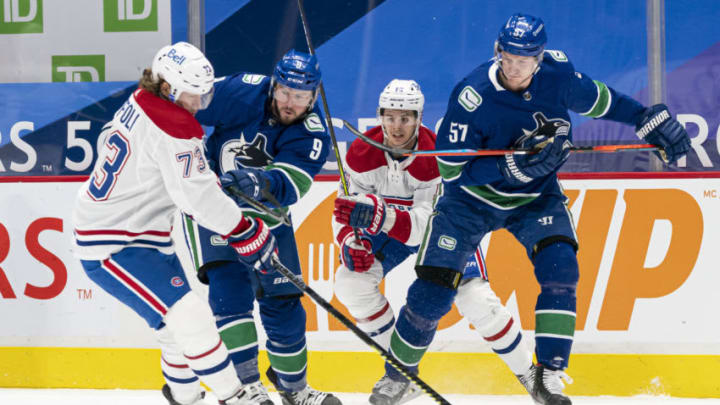
For the most part, the Canucks were consistent with their penalty-killing defencemen, opting for Hamonic, Edler, Myers and Schmidt, but not by choice.
The team couldn’t rely defensively on Juolevi and/or Chatfield at this point in their development, and they weren’t going to add even more minutes to Hughes’ plate, especially since he had some of his own defensive fundamentals to improve upon. That only left the four aforementioned players who, when actually put into the penalty kill situations, ended up dropping the ball most of the time, particularly Edler and Myers, who always appeared one step behind the play.
Believe it or not, the Canucks actually finished the regular season with a higher penalty kill percentage than the Canadiens, sitting at 79.8% versus 78.5%, but it’s important to go beyond the numbers.
The Canadiens had a much better net penalty kill percentage which, according to the league’s revamped statistics section, accounts for how many shorthanded goals a team scores while down a man. As a result, the Canadiens finished 10th in the league at 83.7%, whereas the Canucks finished 14th at 83.1%. Not a huge difference, but Montreal was able to register nine short-handed goals this past season, compared to Vancouver’s six.
Yes, all of their short-handed goals were scored by forwards, but the build-up to the penalty kill production, in large part, was due to Montreal’s defencemen. They were able to effectively control the puck in their own end without panicking, either by blocking incoming shots or by pressuring their opponents enough so that they would cough up the puck. Once that was accomplished, the Montreal defencemen were able to spring the puck forward to one of their teammates for a possible scoring chance.
None of this was a common occurrence for the Canucks’ blueline during the penalty kill. They were often caught scrambling in front of the net, sprawling out much too early to intercept passes, or just making desperate, unsuccessful attempts to clear the puck. The Canucks also relied heavily on Thatcher Demko to limit powerplay scoring opportunities from their opponents, as indicated by his 54 high danger shots against (HDSA) on the penalty kill, according to Natural Stat Trick. This would be good for second-highest in the league, only behind Connor Hellebuyck. Price, on the other hand, only had 43 HDSA.
Again, the numbers aren’t a drastic difference between the two teams, but you can further emphasize the point by seeing which team can replicate their stats during the playoffs as well.
Currently, the Canadiens lead the league in both playoff penalty kill and net penalty kill, which sit at 91.4% and 102.9%. They’ve already scored four short-handed goals, and their defencemen were able to limit offensive juggernauts like Mitch Marner and Auston Matthews to only three combined powerplay points over seven games in the first round. They also kept Vegas’s powerplay at bay in game one, successfully killing off all four of their attempts, but will still definitely need to make more of a disciplined effort to stay out of the box more in game two.
Obviously, we can’t perfectly compare these playoff stats to the Canucks this year, but the next best thing would be to look back on how they performed in the bubble. Over three series, the Canucks posted a penalty kill percentage of 80%, while tallying two shorthanded goals. Not too shabby, but it’s also important to remember that this happened with the services of Tanev and Troy Stecher instead of Hamonic and Schmidt, so it’s not exactly a true comparison. But again, the next best thing.
The bottom line? The Canucks, despite how cohesive and reliable they appeared on paper, will need to work on the overall chemistry and communication of their defencemen. Could they figure it all out as soon as next year? They have the young talent to at least try, but only time will tell. This writer isn’t too optimistic, but he also loves to be proved wrong.
What are your thoughts on how Vancouver’s defence stacks up against Montreal’s? Let us know in the comments below!
